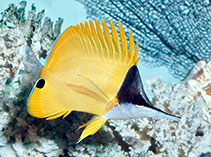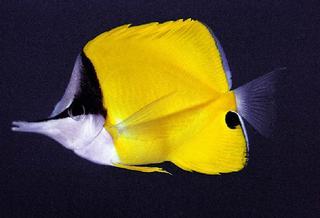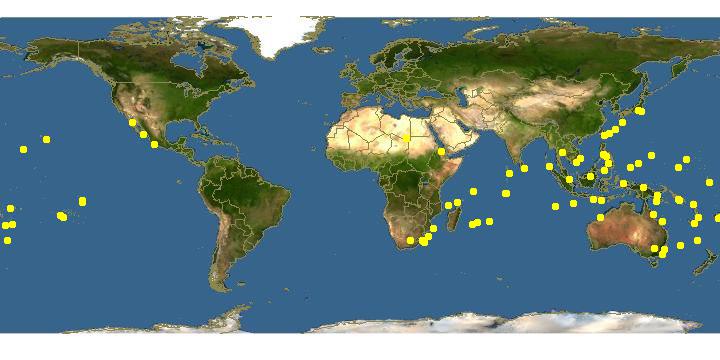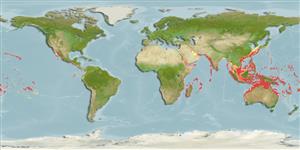|
| Links |
We parsed the following live from the Web into this page. Such content is managed by its original site and not cached on Discover Life. Please send feedback and corrections directly to the source. See original regarding copyrights and terms of use.
- Australian Faunal Directory
- FishBase
|
|
español |
|
|
Overview | |
Main identification features
Forcepsfish, Longnose butterflyfish
Dorsal rays XII,22-24; anal rays III,17 or 18; pectoral rays 15; lateral-line scales 74-80; greatest body depth 1.9-2.4 in standard length; snout extremely long and thin, its length 1.6-2.1 in body depth; mouth with a distinct gape (hence forceps-like).
Overall bright yellow; upper half of head and nape black, white below; a black spot on anal fin just below base of caudal fin.
Size: to 22 cm.
Inhabits rock and coral reefs; feeds on hydroids, small crustaceans, tubed feet of echinoderms, pedicillaria of sea urchins, and polychaete tentacles.
Depth: 1-145 m.
East Africa to the America; the central Gulf of California to Ecuador and the Revillagigedos, Galapagos, Clipperton and Malpelo.
Attributes
Abundance: Common.
Cites: Not listed.
Climate Zone: Northern Subtropical (Cortez Province + Sinaloan Gap); Northern Tropical (Mexican Province to Nicaragua + Revillagigedos); Equatorial (Costa Rica to Ecuador + Galapagos, Clipperton, Cocos, Malpelo).
Depth Range Max: 145 m.
Depth Range Min: 1 m.
Diet: sessile crustacea; sessile worms; soft corals/hydroids; sessile molluscs; sea-stars/cucumbers/urchins; mobile benthic crustacea (shrimps/crabs).
Eastern Pacific Range: Northern limit=28; Southern limit=-2; Western limit=-115; Eastern limit=-78; Latitudinal range=30; Longitudinal range=37.
Egg Type: Pelagic; Pelagic larva.
Feeding Group: Carnivore.
FishBase Habitat: Reef Associated.
Global Endemism: All Pacific (West + Central + East); Indo-Pacific only (Indian + Pacific Oceans); TEP non-endemic; "Transpacific" (East + Central &/or West Pacific); All species.
Habitat: Corals; Reef associated (reef + edges-water column & soft bottom); Rocks; Reef (rock &/or coral); Reef only.
Inshore Offshore: Inshore; Inshore Only.
IUCN Red List: Not evaluated / Listed.
Length Max: 22 cm.
Regional Endemism: Island (s); Continent; Continent + Island (s); Eastern Pacific non-endemic; Tropical Eastern Pacific (TEP) non-endemic; All species.
Residency: Resident.
Salinity: Marine; Marine Only.
Water Column Position: Bottom; Near Bottom; Bottom + water column;
|
|
|
Names | |
|
|
|
Links to other sites | |
|
|
|
References |
- Aburto-Oropeza , O. and Balart, E. F., 2001., Community structure of reef fish in several habitats of a rocky reef in the Gulf of California., Marine Ecology, 22:283-305.
- Allen , G.R. and Robertson, D.R., 1997., An Annotated Checklist of the fishes of Clipperton Atoll, Tropical Eastern Pacific., Revista de Biologia Tropical, 45:813-843.
- Béarez, P., 1996., Lista de los Peces Marinos del Ecuador Continental., Revista de Biologia Tropical, 44:731-741.
- Castro-Aguirre , J. L. , Balart , E. F. and Arvizu-Martínez, J., 1995., Contribución al conocimiento del origen y distribución de la ictiofauna del Golfo de California, México., Hidrobiologica, 5:57-78.
- Castro-Aguirre, J.L. and Balart, E.F., 2002., La ictiofauna de las islas Revillagigedos y sus relaciones zoogeograficas, con comentarios acerca de su origen y evolucion. En: Lozano-Vilano, M. L. (Ed.). Libro Jubilar en Honor al Dr. Salvador Contreras Balderas., Universidad Autonoma de Nuevo León:153-170.
- Elorduy Garay , J. F. and Jiménez Gutiérrez, S. V., 2000., Metodologías para el estudio de los peces de arrecife. En Aburto Oropeza, O. y C. A. Sánchez Ortiz (Eds.). Recursos arrecifales del Golfo de California, estrategias de manejo para las especies marinas de ornato., Universidad Autónoma de Baja California Sur:72-82.
- Findley, L.T., Hendrickx, M.E., Brusca, R.C., van der Heiden, A.M., Hastings, P.A., Torre, J., 2003., Diversidad de la Macrofauna Marina del Golfo de California, Mexico., CD-ROM versión 1.0. Projecto de la Macrofauna del Golfo . Derechos reservados de los autores y Conservación Internacional.
- Fischer , W. , Krup , F. , Schneider , W. , Sommer , C. , Carpenter , K. E. and Niem, V. H., 1995., Guia FAO para la Identificacion de Especies de para los fines de la Pesca. Pacifico Centro-Oriental. Volumen II. Vertebrados - Parte 1., FAO2:647-1200.
- Galván-Magaña, F., Abitia-Cárdenas, L.A., Rodríguez-Romero, J., Pérez-España, H., Chávez-Ramos, H., 1996., Systematics list of the fishes from Cerralvo island, Baja California Sur, Mexico., Ciencias Marinas, 22:295-311.
- Galván-Magaña, F., Gutiérrez-Sánchez, F., Abitia-Cárdenas, L.A., Rodríguez-Romero, J., 2000., The distribution and affinities of the shore fishes of the Baja California Sur lagoons. In Aquatic Ecosystems of Mexico: Status and Scope. Eds. M. Manuwar, S.G. Lawrence, I.F. Manuwar & D.F. Malley. Ecovision World Monograph Series., Backhuys Publishers:383-398.
- Gotshall, D.W., 1996., Fishes of Rocas Alijos. In Rocas Alijos. Ed. R. W. Schmieder. Cornell Expeditions., Kluwer Academic Publishers: 347-354.
- Humann, P., 1993., Reef Fish Identification: Galapagos., New World Publishing:192pp.
- Jimenez-Prado, P., Béarez, P., 2004., Peces marinos del Ecuador continental / Marine fishes of continental Ecuador., SIMBIOE/NAZCA/IFEA tomo 1 y 2.
- Jordan , D.S. and Evermann, B.W., 1898., The fishes of North and Middle America: a descriptive catalogue of the species of fish-like vertebrates found in the waters of North America, north of the Isthmus of Panama. Part II., Bull. U.S. Nat. Mus., 47:1241-2183.
- Jordan , and McGregor,., 1898., List of fishes collected at the Revillagigedo archipelago and neighboring islands., Rept. U.S. Fisheries Comm., 24:271-284.
- Love, M.S., Mecklenburg, C.W., Mecklenburg, T.A., Thorsteinson, L.K., 2005., es of the West Coast and Alaska: a checklist of North Pacific and Artic Ocena species from Baja California to the Alaska-Yukon border., U.S. Department of the Interior, U.S. Geological Survey, Biological Resources Division, 288pp.
- McCosker , J.E. and Humann, P.H., 1996., New records of Galápagos fishes., Charles Darwin Foundation, Noticias de Galápagos., 56:18-26.
- Robertson , D.R. and Allen, G.A., 1996., Zoogeography of the shorefish fauna of Clipperton Atoll., Coral Reefs, 15:121-131.
- Rosenblatt , R.H. , McCosker , J.E. and Rubinoff, I., 1972., Indo-west Pacific fishes from the Gulf of Chiriqui, Panama., Contrib. Sci. Nat. Hist. Mus. Los Angeles Co., 234:18pp.
- Sánchez Ortíz , C. , Arreola Robles , J. L. , Aburto Oropeza , O. and Cortés Hernández, M., 1997., Peces de arrecife en la región de La Paz, B.C.S.. En Urbán Ramírez, J. y M. Ramírez Rodríguez (Eds.). La Bahía de La Paz investigación y conservación., Universidad Autónoma de Baja California Sur:189-200.
- Thomson , D.A. , Findley , L.T. and Kerstitch, A.N., 2000., Reef fishes of the Sea of Cortez., University of Texas Press(Revised Ed.):353.
- Villareal-Cavazos, A., Reyes-Bonilla, H., Bermúdez-Almada, B. and Arizpe-Covarrubias, O., 2000., Los peces del arrecife de Cabo Pulmo, Golfo de California, México: Lista sistemática y aspectos de abundancia y biogeografía., Rev. Biol. Trop., 48:413-424.
- Walker, B. W. and Baldwin, W. J., 1964., Provisional check list of fishes of the Revillagigedo islands., 18 pp.
|
|
|
Acknowledgements | |
I thank Ashley MacDonald and John Pickering, University of Georgia, for technical support in building this page.
|
|
| Supported by | |
|
Following modified from Australian Faunal Directory
|
Top | See original
| &pull 20q v5.145 20180528: Error 301 Moved Permanently http://biodiversity.org.au/afd/taxa/0ad0ae97-5a36-44e9-a680-b62ee074d758 |
|
Following modified from FishBase
|
Top | See original
http://www.fishbase.org/Summary/speciesSummary.php?genusname=Forcipiger&speciesname=flavissimus ---> http://192.134.151.83/Summary/speciesSummary.php?genusname=Forcipiger&speciesname=flavissimus
http://192.134.151.83/Summary/speciesSummary.php?genusname=Forcipiger&speciesname=flavissimus ---> https://fishbase.mnhn.fr/Summary/speciesSummary.php?genusname=Forcipiger&speciesname=flavissimus
https://fishbase.mnhn.fr/Summary/speciesSummary.php?genusname=Forcipiger&speciesname=flavissimus ---> https://fishbase.mnhn.fr/summary/Forcipiger-flavissimus.html
Forcipiger flavissimus, Longnose butterfly fish : aquarium

You can
sponsor
this page
Common name (e.g. trout)
Genus + Species (e.g. Gadus morhua)
-

-
About this page
-
Languages
-
User feedbacks
-
Citation
-
Uploads
-
Related species
-


 Longnose butterfly fish
Add your observation in
Fish Watcher
Upload your
photos
and
videos
Longnose butterfly fish
Add your observation in
Fish Watcher
Upload your
photos
and
videos
Pictures
|
Videos |
Stamps, Coins Misc.
|
Google image
 Forcipiger flavissimus
Forcipiger flavissimus
Picture by
Muséum-Aquarium de Nancy/D. Terver
Teleostei (teleosts) >
Acanthuriformes
(Surgeonfishes) >
Chaetodontidae
(Butterflyfishes)
Etymology:
Forcipiger:
Latin, forceps = instrument of the pincers kind used for seizing and holding objects, esp. In surgical and obstetric operations + latin, gero = to carry; 1634 (Ref.
45335
)
.
More on authors:
Jordan
&
McGregor
.
Environment: milieu / climate zone / depth range / distribution range
Ecology
Marine; reef-associated; non-migratory; depth range 0 - 145 m (Ref.
89467
). Tropical; 36°N - 32°S, 30°E - 79°W
Indo-Pacific: Red Sea and East Africa (Ref.
12484
) to the Hawaiian and Easter islands, north to southern Japan, south to Lord Howe Island; throughout Micronesia. Eastern Pacific: southern Baja California, Mexico and from the Revillagigedo and Galapagos Islands (Ref.
5227
,
11482
).
Size / Weight / Age
Maturity: L
m
?
range ? - ? cm
Max length : 22.0 cm TL male/unsexed; (Ref.
9710
); max. reported age: 18 years (Ref.
72479
)
Dorsal
spines
(total): 12 - 13;
Dorsal
soft rays
(total): 19-25;
Anal
spines
: 3;
Anal
soft rays
: 17 - 19.
Common in exposed seaward reefs but also found in lagoon reefs (Ref.
9286
). Benthopelagic (Ref.
58302
). Solitary or in small groups of up to 5 individuals (Ref.
9286
). Adults usually in pairs (Ref.
48636
). Feed on a wide variety of animal prey including hydroids, fish eggs, small crustaceans but prefers tube feet of echinoderms, pedicilaria of sea urchins, and polychaete tentacles (Ref.
1602
). Oviparous (Ref.
205
), monogamous (Ref.
52884
). Form pairs during breeding (Ref.
205
). Second most important export in Hawaii (Ref.
37816
). Minimum depth reported taken from Ref. 128797.
Life cycle and mating behavior
Maturity
|
Reproduction
|
Spawning
|
Eggs
|
Fecundity
|
Larvae
Distinct pairing (Ref.
205
). Monogamous mating is observed as both obligate and social (Ref.
52884
).
Myers, R.F.
, 1991. Micronesian reef fishes. Second Ed. Coral Graphics, Barrigada, Guam. 298 p. (Ref.
1602
)
IUCN Red List Status (Ref.
130435
)
Least Concern (LC)
; Date assessed:
09 October 2009
CITES
Not Evaluated
Not Evaluated
Threat to humans
Harmless
Human uses
Fisheries: of no interest; aquarium: commercial
FAO - Publication:
search
|
FishSource
|
Sea Around Us
More information
Countries
FAO areas
Ecosystems
Occurrences
Introductions
Stocks
Ecology
Diet
Food items
Food consumption
Ration
Common names
Synonyms
Metabolism
Predators
Ecotoxicology
Reproduction
Maturity
Spawning
Spawning aggregation
Fecundity
Eggs
Egg development
Age/Size
Growth
Length-weight
Length-length
Length-frequencies
Morphometrics
Morphology
Larvae
Larval dynamics
Recruitment
Abundance
BRUVS
References
Aquaculture
Aquaculture profile
Strains
Genetics
Electrophoreses
Heritability
Diseases
Processing
Nutrients
Mass conversion
Collaborators
Pictures
Stamps, Coins Misc.
Sounds
Ciguatera
Speed
Swim. type
Gill area
Otoliths
Brains
Vision
Tools
Bio-Quiz
|
E-book
|
Field guide
|
Identification keys
|
Length-frequency wizard
|
Life-history tool
|
Point map
|
Classification Tree
|
Catch-MSY
|
Special reports
Check for Aquarium maintenance
|
Check for Species Fact Sheets
|
Check for Aquaculture Fact Sheets
Download XML
Summary page
|
Point data
|
Common names
|
Photos
Internet sources
AFORO (otoliths)
|
Aquatic Commons
|
BHL
|
Cloffa
|
BOLDSystems
|
Websites from users
|
Check FishWatcher
|
CISTI
|
Catalog of Fishes
:
genus
,
species
|
DiscoverLife
|
DORIS
|
ECOTOX
| FAO - Publication:
search
|
Faunafri
|
Fishipedia
|
Fishtrace
| GenBank:
genome
,
nucleotide
|
GloBI
|
Google Books
|
Google Scholar
|
Google
| IGFA World Record |
MitoFish
|
National databases
|
Otolith Atlas of Taiwan Fishes
|
Public aquariums
|
PubMed
|
Reef Life Survey
| Socotra Atlas |
Tree of Life
| Wikipedia:
Go
,
Search
| World Records Freshwater Fishing |
Zoobank
|
Zoological Record
Estimates based on models
Preferred temperature (Ref.
123201
): 24.3 - 28.8, mean 27.5 °C (based on 710 cells).
Phylogenetic diversity index (Ref.
82804
): PD
50
= 0.6250 [Uniqueness, from 0.5 = low to 2.0 = high].
Bayesian length-weight: a=0.02239 (0.01117 - 0.04486), b=3.02 (2.85 - 3.19), in cm total length, based on LWR estimates for this (Sub)family-body shape (Ref.
93245
).
Trophic level (Ref.
69278
): 3.1 ±0.2 se; based on diet studies.
Resilience (Ref.
120179
): High, minimum population doubling time less than 15 months (Preliminary K or Fecundity.).
Fishing Vulnerability (Ref.
59153
): Low vulnerability (12 of 100).
Nutrients (Ref.
124155
): Calcium = 77.3 [40.2, 116.8] mg/100g; Iron = 0.735 [0.446, 1.180] mg/100g; Protein = 18.5 [17.4, 19.7] %; Omega3 = 0.129 [0.079, 0.208] g/100g; Selenium = 44.4 [24.8, 80.8] μg/100g; VitaminA = 44.4 [12.5, 154.3] μg/100g; Zinc = 1.25 [0.86, 1.79] mg/100g (wet weight);
Back to Search
Random Species
Back to Top
Accessed through:
Not available
FishBase mirror site :
localhost
Page last modified by :
mrius-barile
- 20 July 2016
Fatal error
: Uncaught ArgumentCountError: Too few arguments to function checkEcotox(), 1 passed in /var/www/html/summary/speciessummary.php on line 2304 and exactly 3 expected in /var/www/html/includes/speciessummary.lib.php:2579 Stack trace: #0 /var/www/html/summary/speciessummary.php(2304): checkEcotox() #1 {main} thrown in
/var/www/html/includes/speciessummary.lib.php
on line
2579
|
Updated: 2024-05-24 16:07:40 gmt
|







